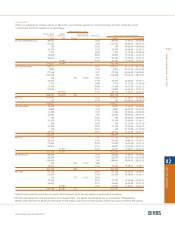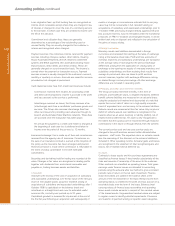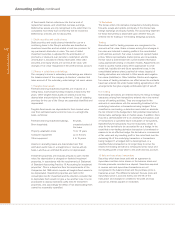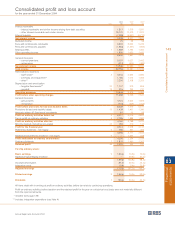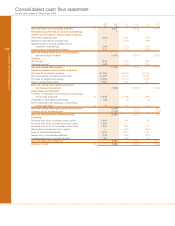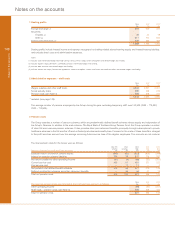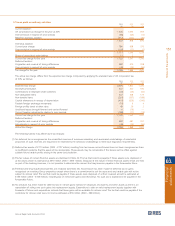RBS 2004 Annual Report Download - page 143
Download and view the complete annual report
Please find page 143 of the 2004 RBS annual report below. You can navigate through the pages in the report by either clicking on the pages listed below, or by using the keyword search tool below to find specific information within the annual report.
section
03
141
Annual Report and Accounts 2004
Accounting policies
Financial
statements
7 General insurance
General insurance comprises short-duration contracts and
include principally property and liability insurance contracts.
Due to the nature of the products sold – retail based property
and casualty, motor, home and personal health insurance
contracts – the insurance protection is provided on an even
basis throughout the term of the policy.
In calculating operating profit from general insurance activities,
premiums (net of reinsurance premiums) are recognised in the
accounting period in which they begin. Unearned premiums
represent the proportion of the net premiums that relate to
periods of insurance after the balance sheet date and are
calculated over the period of exposure under the policy, on a
daily basis, 24th’s basis or allowing for the estimated incidence
of exposure under policies which are longer than twelve
months. Provision is made where necessary for the estimated
amount required over and above unearned premiums net of
reinsurance, including that in respect of future written business
on discontinued lines under the run-off of delegated underwriting
authority arrangements. It is designed to meet future claims
and related expenses and is calculated across related classes
of business on the basis of a separate carry forward of
deferred acquisition expenses after making allowance for
investment income.
Acquisition expenses relating to new and renewed business for
all classes are deferred over the period during which the
premiums are unearned. The principal acquisition costs so
deferred are commissions payable, direct advertising expenditure,
costs associated with the telesales and underwriting staff and
prepaid claims handling costs in respect of delegated claims
handling arrangements for claims which are expected to occur
after the balance sheet date.
Claims (net of reinsurance) are recognised in the accounting
period in which the loss occurs. Provision is made for the full
cost (net of reinsurance) of settling outstanding claims at the
balance sheet date, including claims estimated to have been
incurred but not yet reported at that date, and claims handling
expenses.
8 Long-term life assurance business
The Group’s long-term assurance business includes whole-life,
guaranteed renewable term life, endowment, annuity and
universal life contracts that are expected to remain in force for
an extended period of time, generally five to forty years.
The value placed on the Group’s long-term life assurance
business comprises the net assets of the Group’s life
assurance subsidiaries, including its interest in the surpluses
retained within the long-term assurance funds, and the present
value of profits inherent in in-force policies. In calculating the
value of in-force policies, future surpluses expected to emerge
are estimated using appropriate assumptions as to future
mortality, persistency and levels of expenses, which are then
discounted at a risk-adjusted rate. Changes in this value,
which is determined on a post-tax basis, are included in
operating profit, grossed up at the underlying rate of taxation.
Long-term assurance assets attributable to policyholders are
valued on the following bases: equity shares and debt
securities at market price; investment properties and loans at
valuation. These assets are held in the life funds of the Group’s
life assurance companies, and although legally owned by
them, the Group only benefits from these assets when surpluses
are declared. To reflect the distinct nature of the long-term
assurance assets, they are shown separately on the consolidated
balance sheet, as are liabilities attributable to policyholders.
The Group has reinsured contracts that transfer significant
insurance risk. Within net assets, the reinsurance cash flows
are recognised when they become payable. For most contracts
this effectively spreads the cost of reinsurance over the life of
the reinsured contracts. In some cases, the acquisition costs
are financed by the reinsurer offering a nil premium payment
period. In these cases, the acquisition costs incurred on the
underlying insurance contracts are compared with the benefit
arising with respect to the nil premium paying period on the
reinsurance contract.
9 Loans and advances
The Group makes provisions for bad and doubtful debts,
through charges to the profit and loss account, so as to record
impaired loans and advances at their expected ultimate net
realisable value.
Specific provisions are made against individual loans and
advances that the Group no longer expects to recover in full.
For the Group’s portfolios of smaller balance homogeneous
advances, such as credit card receivables, specific provisions
are established on a portfolio basis taking into account the
level of arrears, security and past loss experience. For loans
and advances that are individually assessed, the specific
provision is determined from a review of the financial condition
of the borrower and any guarantor and takes into account the
nature and value of any security held.
The general provision is made to cover bad and doubtful debts
that have not been separately identified at the balance sheet
date but are known to be present in any portfolio of advances.
The level of general provision is determined in the light of past
experience, current economic and other factors affecting the
business environment and the Group’s monitoring and control
procedures, including the scope of specific provisioning
procedures.
Specific and general provisions are deducted from loans and
advances. When there is significant doubt that interest
receivable can be collected, it is excluded from the profit and
loss account and credited to an interest suspense account.
Loans and advances and suspended interest are written off in
part or in whole when there is no realistic prospect of recovery.
10 Taxation
Provision is made for taxation at current enacted rates on
taxable profits taking into account relief for overseas taxation
where appropriate. Timing differences arise where gains and
losses are accounted for in different periods for financial
reporting purposes and for taxation purposes. Deferred
taxation is accounted for in full for all such timing differences,
except in relation to revaluations of fixed assets where there is
no commitment to dispose of the asset, taxable gains on sales


